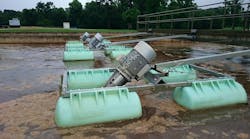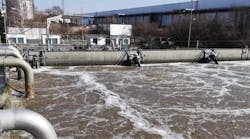Operations and maintenance (O&M) personnel in manufacturing plants regularly monitor incoming, in-process and outgoing (effluent) water to meet quality control specifications, optimize production and wastewater treatment processes, and comply with a range of federal, state and/or local regulatory requirements. Regardless of the end product, water quality monitoring processes usually involve relatively expensive and time-consuming grab sample and chemical lab testing. As an alternative, a growing number of end users are implementing faster, more efficient monitoring systems with compact UVC LED-based sensors.
These sensors – which use UV photometry to identify water contaminants in real time – collect water quality data continuously at multiple locations throughout a plant’s incoming and outgoing water network. Instead of waiting days for grab sample and laboratory testing results, O&M personnel can identify and correct water quality issues in a matter of hours, which greatly reduces O&M expenses and the risk of costly regulatory compliance violations.
Monitoring incoming water quality
First-generation ultraviolet-visible spectroscopy (UV/Vis) probes that were used for real-time monitoring included either deuterium or xenon flash lamps, which provided a broad spectrum of wavelengths, and a photodiode array (PDA) for detection. While popular, these and associated electronics increased the probe costs to more than $20,000.
Most industrial water systems must measure specific parameters such as chemical oxygen demand (COD) and biological oxygen demand (BOD). In this case, a full-spectrum analysis with a PDA is not necessary. Instead, lower-cost probes designed around a miniature array of LEDs – with the wavelength selection based on specific parameters to be measured – combined with simple photodiode detectors can be used.
With advancements in high-performance UVC LEDs, design engineers can reduce sensor costs by 40 to 80 percent and develop small yet powerful instruments tailored to specific water quality measurement applications.
Consider, for example, the benefits that smaller, more efficient, LED-based sensors provide to the food and beverage industry. By replacing intermittent grab sample chemical testing with continuous spectroscopic sampling, O&M personnel at food and beverage facilities can monitor process information, detect water quality issues and make needed changes in real time – often in a matter of hours.
This is important because water supplies tend to vary in taste, odor, chemistry and microbes, potentially altering the final product. Multinational food brands must closely monitor each plant’s water quality to ensure that a product tastes the same no matter where it is produced. To do that, most rely on total organic carbon (TOC) grab sample analyses to monitor water quality throughout the manufacturing process. Chemical grab sample methods in the lab based on persulfate oxidation are expensive, require more time between measurements and have high consumable costs.
As an alternative, instantaneous TOC analyses can be performed via absorption spectroscopy at 255 nanometers (nm). Sensors equipped with UVC LEDs can achieve the same results for any subset of parameters such as UV transmittance (UVT) or COD.
With consumer and regulatory pressures for food safety increasing, global regulations are expected to tighten. Since UVC LED-based sensors are precise and deliver data in real time, this new class of sensors can help food and beverage manufacturers monitor process water TOC, maintaining a consistent, high-quality product, regardless of where it is produced.
Monitoring in-process quality
A second important application centers on chemical-based clean-in-place (CIP) systems, which use chemicals to clean and disinfect food and beverage production equipment after each run cycle. To control costs, O&M personnel keep close tabs on the chemicals that the CIP system consumes. Overdosing may corrode production equipment and increase chemical costs, while too little disinfectant may lead to contamination and jeopardize food safety.
UV fluorescence spectroscopy is ideally suited to this type of bacterial concentration monitoring because it detects rinse water concentrations in parts-per-billion, making it as much as 1,000 times more sensitive than traditional absorption spectroscopy.
By measuring bacterial concentrations with UV spectroscopy, O&M personnel can monitor and verify the cleaning process’ effectiveness between production runs. UVC LED-based spectroscopy instruments allow operators to more accurately measure the CIP system’s tryptophan signal, thereby ensuring the most efficient use of chemicals – not too much, not too little – throughout the cleaning process.
Further, UVC LEDs can help the industry reduce production costs by optimizing CIP manufacturing processes – prolonging the working life of expensive food processing equipment, improving overall product quality and bolstering corporate food safety measures.
Monitoring effluent quality
LEDs are also used to measure water quality prior to its release from a plant as effluent. A high percentage of wastewater is discharged from industrial plants without being treated in some developing countries. As a solution, new water quality monitoring programs are being implemented that use LED-based sensors to meet a range of environmental standards. While plant owners rely on the sensors to ensure they meet government regulations and avoid costly fines, regulators are beginning to use them to monitor compliance.
In 2015, India’s Central Pollution Control Board (CPCB) implemented the first large-scale environmental monitoring program of its kind – a wireless, communications-based system that automatically collects water quality sample data from tens of thousands of industrial facilities every 15 minutes. The system, which includes the use of LED-based sensors, gives the CPCB regulators the ability to remotely monitor and enforce the country’s clean water standards.
China has unveiled its landmark “Water Ten” plan. The idea is to improve water quality by focusing on reducing pollution from its 10 major polluting industries.
The plan calls for the comprehensive supervision of water quality from source to tap by local governments, performance that will then be reviewed by the central government and made public.
Factory owners in developing countries previously would simply “clean up and behave well” when government representatives visited to collect grab samples, which were then analyzed in a lab. As a result, about 40 percent of treated/discharged industrial water up until now has not met India’s quality standards, with similar numbers reported in China.
In India, sensors (probes) will soon measure and send regulators data on each facility’s BOD, COD, pH level, total suspended solids, nitrate level and turbidity. These measurements will be collected via chemical methods or UV spectroscopy at UVC wavelengths of 280 nm and 255 nm, respectively.
Because of their lower costs, operation and maintenance expenses, most of the monitoring systems’ optical sensors are expected to use LEDs. In 2015 alone, approximately 3,200 companies in India were scheduled to install monitoring systems at their plants with data to be sent in real time to a centralized government server.
Cost-effective monitoring with UVC LED-based sensors
Water quality instrumentation manufacturers have long been aware of the advantages of UV lamp technologies. With major advancements in UVC LEDs, instrument manufacturers can develop flexible water quality monitoring sensors at 40 to 80 percent of a lamp-based system’s cost – a key benefit in developing countries. Further, these small yet powerful sensors can be custom-made to address industry or plant-specific water quality measurement requirements.
Going forward, industrial plant owners and their regulators can choose from a growing range of UVC LED-based sensors to measure multiple water quality parameters, verify the quality of incoming water, optimize plant production processes and ensure that wastewater meets individually prescribed regulatory targets well before discharge into the environment.




